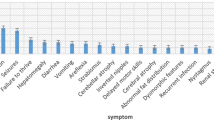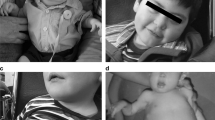Abstract
Summary: Congenital disorders of glycosylation (CDG) represent a family of genetic diseases with broad clinical presentation. Initial diagnosis is currently mainly based on the identification of hyposialylated serum transferrin (TF) by isoelectric focusing (IEF). To improve the diagnosis of known CDG types and to identify so far unknown CDG cases, additional glycoproteins, α1-antitrypsin (α1-AT) and α1-antichymotrypsin (α1-ACT), were studied. According to the patterns of transferrin, enzyme assays and mutation analysis, 16 patients with various clinical symptoms suspicious for CDG were divided into three groups: group A (n = 6) with confirmed CDG; group B (n = 4) with clear abnormal TF-IEF patterns of unknown origin (all known CDG types were excluded) and group C (n = 6) with borderline TF-IEF patterns; 164 samples served as a control group. Automated IEF of TF, α1-AT and α1-ACT was carried out using a PhastSystem. CDG patients with glycosylation defects of known origin (group A) and patients with abnormal TF-IEF patterns due to glycosylation defects of as yet unknown origin (group B) showed abnormal IEF patterns of all three glycoproteins. These results confirmed generalized defects of glycosylation. Furthermore, the IEF pattern of α1-ACT seems to allow a differentiation between CDG Ia and CDG Ic. However, patients with borderline TF-IEF pattern (group C) showed a normal α1-AT-IEF pattern. Four of these six patients also showed a normal α1-ACT-IEF pattern; this constellation suggests that CDG can most likely be excluded. In the two remaining patients of group C with a borderline TF-IEF pattern an abnormal pattern of α1-ACT-IEF was obtained which needs further investigations. We conclude that the combined investigation of three glycoproteins provides additional information in the diagnostic work-up of patients with possible CDG. The suspicion of CDG in patients with apparent glycosylation defects of unknown origin or borderline TF-IEF pattern can be either substantiated or weakened.
Similar content being viewed by others
REFERENCES
Adamowicz M, Pronicka E (1996) Carbohydrate deficient glycoprotein syndrome-like transferrin isoelectric focusing pattern in untreated fructosaemia. Eur J Pediatr 155: 347–348.
Assmann B, Hackler R, Peters V, Schaefer JR, Hoffmann GF (2000) Increased carbohydrate-deficient transferrin concentration and abnormal protein glycosylation of unknown etiology in a patient with achondroplasia. Clin Chem 46: 584–586.
Burda P, Borsig L, de Rijk-van Andel J, Wevers R, et al (1998) A novel carbohydrate-de?cient glycoprotein syndrome characterized by a deficiency in glucosylation of the dolichol-linked oligosaccharide. J Clin Invest 102: 647–652.
Charlwood J, Clayton P, Keir G, Mian N, Winchester B (1998) Defective galactosylation of serum transferrin in galactosemia. Glycobiology 8: 351–357.
Clayton P, Winchester B, Di Tomaso E, Young E, Keir G, RodeckC (1993) Carbohydrate-deficient glycoprotein syndrome: normal glycosylation in the fetus. Lancet 341: 956–960.
Dupre T, Barnier A, de Lonlay P, Cormiere-Daire V, et al (2000) Defect in N-glycosylation of proteins is tissue-dependent in congenital disorder of glycosylation Ia. Glycobiology 10: 1277–1281.
Dupre T, Cuer M, Barrot S, Cormier-Daire V, et al (2001) Congenital disorder of glycosylation Ia with deficient phosphomannomutase activity but normal plasma glycoprotein pattern. Clin Chem 47: 132–134.
Hackler R, Arndt T, Peters V, Assmann B, Hoffman GF, Steinmetz A (1998) Automated isoelectric focusing of serum isotransferrins for laboratory diagnosis of carbohydrate de?cient glycoprotein syndrome using the PhastSystemTM. Scand J Clin Lab Invest 58(supplement 228): 66–67.
Hagberg BA, Blennow G, Kristiansson B, Stibler H (1996) Carbohydrate-deficient glycoprotein syndromes. In Moser HW, ed. Handbook of Clinical Neurology. Vol 66. Neurodystrophies and Neurolipidoses. Amsterdam: Elsevier Science, 623–637.
Hanßke B, Thiel C, Lübke, et al (2002) Deficiency of UDP-galactose: N-acetylglucosamine b-1, 4-galactosyltransferase I causes the congenital disorder of glycosylation type IId. JClin Invest 109: 725–733.
Harrison HH, Miller KL, Harbison MD, Slonim AE (1992) Multiple serum protein abnormalities in carbohydrate-deficient glycoprotein syndrome: pathognomonic finding of two-dimensional electrophoresis. Clin Chem 38: 1390–1392.
Heyne K, Weidinger S (1992) Diagnostikund Nosologie der Glykanose CDG ('carbohydrate-deficient glycoprotein-syndrome'). Monatsschr Kinderheilkd 140: 822–827.
Heyne K, Weidinger S (1994) Drei neue biochemische Marker bei Glykanose CDG (carbohydrate-deficient glycoprotein syndrome). Monatsschr Kinderheilkd 142: 199–204.
Heyne K, Schröder M, Körner C, Hanefeld F, Stephani, Weidinger S (2000) Marker molecules (AAT) with normal glycosylation pattern in the 'pre-Golgi'-types (I) of glycanosis CDGS. Neuropediatrics 31: A21.
Holzbach U, Christen HJ, Hanefeld F (1997) Das Klinische Spektrum des CDG-Syndroms. Padiat Prax 52: 627–636.
Imbach T, SchenkB, Schollen E, et al (2000) Deficiency of dolichol-phosphate-mannose synthase-1 causes congenital disorder of glycosylation type Ie. J Clin Invest 105: 233–239.
Imtiaz F, Worthington V, Champion M, et al (2000) Genotypes and phenotypes of patients in the UK with carbohydrate-deficient glycoprotein syndrome type I. J Inherit Metab Dis 23: 162–174.
Jaeken J (2003) Congenital disorders of glycosylation (CDG): It's all in it! J InheritMetab Dis 26: 99–118.
Jaeken J, Carchon H, Stibler H (1993) The carbohydrate-deficient glycoprotein syndrome: pre-golgi and golgi disorders? Glycobiology 3: 423–428.
Körner C, Knauer R, Holzbach U, Hanefeld F, Lehle L, von Figura K (1998) Carbohydrate-deficient glycoprotein syndrome type V: deficiency of dolichyl-P-Glc: Man9GlcNAc2-PP-dolichyl glucosyltransferase. Proc Natl Acad Sci USA 95: 13200–13205.
Körner C, Knauer R, Stephani U, Marquardt T, Lehle L, von Figura K (1999) Carbohydrate deficient glycoprotein syndrome type IV: deficiency of dolichyl-P-Man:Man5GlcNAc2-PP-dolichyl mannosyltransferase. EMBO J 18: 6816–6822.
Noll B, Hackler R, Pelzer M, et al (1999) Semi-automated rapid isoelectric focusing of apolipoproteins C from human plasma using PhastSystemTM and immunofixation. Clin Chem Lab Med 37: 643–648.
Ohno K, Yuasa I, Akaboshi S, et al (1992) The carbohydrate deficient glycoprotein syndrome in three Japanese children. Brain Dev 14: 30–35.
Participants (1999) First International Workshop on CDGS, Leuven, Belgium, November 12-13, 1999. Carbohydrate-deficient glycoprotein syndromes become congenital disorders of glycosylation: An updated nomenclature for CDG. Glycoconj J 16: 669–671.
Peters V, Penzien JM, Reiter G, et al (2001) Congenital disorder of glycosylation IId (CDG-IId)Ua new entity: Clinical presentation with Dandy-Walker malformation and myopathy. Neuropediatrics 33: 27–32.
Stibler H, Holzbach U, Kristiansson B (1998) Isoforms and levels of transferrin, antithrombin, a1-antitrypsin and thyroxine-binding globulin in 48 patients with carbohydrate-de?cient glycoprotein syndrome type I. Scand J Clin Lab Invest 58: 55–62.
Author information
Authors and Affiliations
Additional information
An erratum to this article is available at http://dx.doi.org/10.1007/s10545-005-7310-6.
Rights and permissions
About this article
Cite this article
Fang, J., Peters, V., Körner, C. et al. Improvement of CDG diagnosis by combined examination of several glycoproteins. J Inherit Metab Dis 27, 581–590 (2004). https://doi.org/10.1023/B:BOLI.0000042982.82131.a4
Issue Date:
DOI: https://doi.org/10.1023/B:BOLI.0000042982.82131.a4




